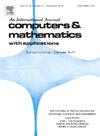Dynamic analysis of the three-phase magneto-electro-elastic (MEE) structures with the overlapping triangular finite elements
IF 2.9
2区 数学
Q1 MATHEMATICS, APPLIED
引用次数: 0
Abstract
The conventional finite element method (FEM) usually fails to generate sufficiently fine numerical solutions in the analyses of Mageto-electro-elastic (MEE) structures in which three different types of physical fields are coupled together. To enhance the performance of the FEM in analyzing MEE structures, in this work a novel overlapping triangular finite element is introduced for dynamic analysis of MEE structures. In this new paradigm for finite element analysis, both local and global numerical approximations are used to construct the considered three-phase physical fields. The local numerical approximation is built by using the method of finite spheres (MFS) and the global numerical approximation is based on the traditional finite element interpolation. In the local numerical approximation, the polynomials or other specially-designed functions can be used as the nodal degrees of freedom. Free vibration and harmonic response analyses are carried out to show the abilities of the overlapping triangular elements in analyzing the three-phase MEE structures. It is demonstrated by the numerical solutions that the present overlapping triangular elements are much more effective to predict the dynamic behaviors of the MEE structures and more accurate solutions can be generated than the traditional FEM with the same mesh. Therefore, the present overlapping triangular elements embody great potential in analyzing various complicated MEE structures in practical engineering applications.
基于重叠三角形有限元的三相磁电弹性结构动力学分析
传统的有限元方法(FEM)在分析三种不同类型的物理场耦合在一起的磁-电弹性(MEE)结构时,往往不能得到足够精细的数值解。为了提高有限元法在MEE结构分析中的性能,本文引入了一种新的重叠三角形有限元法用于MEE结构的动力分析。在这种新的有限元分析范式中,使用局部和全局数值近似来构建所考虑的三相物理场。局部数值逼近采用有限球法(MFS),全局数值逼近采用传统有限元插值法。在局部数值逼近中,可以使用多项式或其他特殊设计的函数作为节点自由度。通过自由振动和谐波响应分析,证明了重叠三角形单元分析三相MEE结构的能力。数值计算结果表明,与传统有限元方法相比,采用重叠三角形单元法可以更有效地预测结构的动力特性,并能得到更精确的解。因此,目前的三角重叠单元在实际工程应用中对各种复杂MEE结构的分析具有很大的潜力。
本文章由计算机程序翻译,如有差异,请以英文原文为准。
求助全文
约1分钟内获得全文
求助全文
来源期刊

Computers & Mathematics with Applications
工程技术-计算机:跨学科应用
CiteScore
5.10
自引率
10.30%
发文量
396
审稿时长
9.9 weeks
期刊介绍:
Computers & Mathematics with Applications provides a medium of exchange for those engaged in fields contributing to building successful simulations for science and engineering using Partial Differential Equations (PDEs).
 求助内容:
求助内容: 应助结果提醒方式:
应助结果提醒方式:


